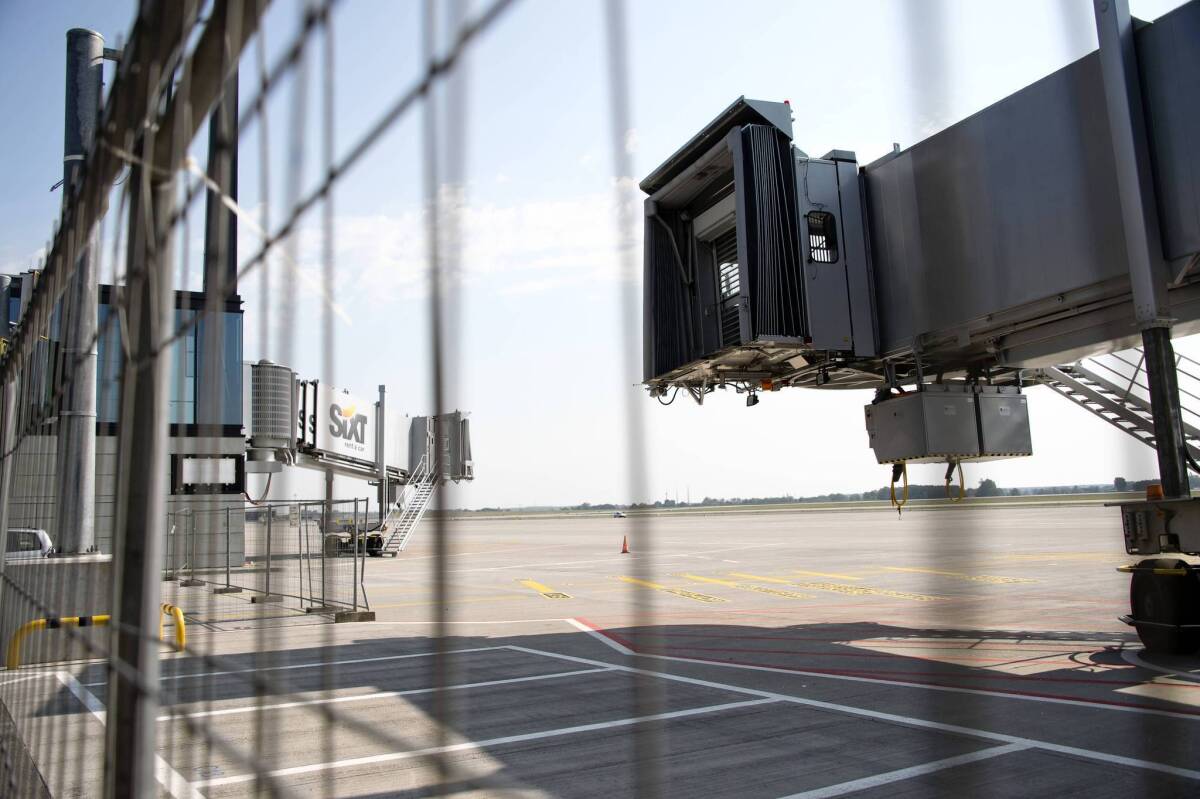New Berlin airport is number who-knows for takeoff

BERLIN — By now, the sleek new Berlin Brandenburg Airport was supposed to be bustling with passengers. But the opening has already been delayed three times, and the main terminal looks more like an abandoned movie set than the busy hub that was built to connect Germany’s capital with the rest of the world.
Computer monitors, chairs and line dividers remain wrapped in plastic. A giant tapestry made of thin red woven aluminum strips, by Los Angeles artist Pae White, hangs unobserved above empty check-in counters and pristine marble tiles.
In a country renowned for no-nonsense efficiency, the drama is a drastic departure from the usual script. The airport was initially scheduled to open in October 2011, and doubts now surround the latest revised debut date of Oct. 27, 2013.
“It’s embarrassing that the deadline had to be moved three times because of planning and technical problems in a country where everything normally functions so well,” said Anton Hofreiter, a Green party lawmaker who heads Parliament’s Committee on Transport, Building and Urban Development.
The saga also plays out as Germany preaches industrial efficiency and competitiveness to its Southern European neighbors in the midst of the euro debt crisis.
While cost overruns and delays are often de rigueur for new airports, the opening of Terminal 4 at Madrid’s airport in 2006 is an example of a project that was relatively on time and on budget, according to Cathy Buyck, a senior analyst for the Center for Aviation in Brussels.
“One would think in Southern Europe everybody is more lax with deadlines,” Buyck said. “But the opening went smoothly and they did learn from mistakes” with previous projects.
The plan to consolidate Berlin’s three airports was conceived in 1996, six years after the capital was moved from Bonn after reunification of West and East Germany.
About 24 million passengers now pass through Tegel and Schoenefeld airports every year. Passenger traffic in 2011 grew 12.6% from 2010 at Tegel, and the increase is supposed to be even bigger this year. A third airport, Tempelhof, closed in 2008.
The Brandenburg facility, spread out over 5.7 square miles, will have an initial capacity of 27 million passengers a year and could eventually expand to 45 million. Still, with only eight baggage-claim carousels, 36 security lines and 10 check-in areas, the airport could be overrun as soon as it’s opened.
Construction began in 2005. But the project was plagued from the beginning by bickering between the city of Berlin; the surrounding state of Brandenburg, where the airport is located; and the federal government, which owns a 26% share.
Government overseers and building designers redrafted plans repeatedly as they tried to balance costs with the needs for a state-of-the-art airport. Terminals kept being expanded. Deadlines kept getting pushed back.
Planners insisted that an opening date of June 3, 2012, would be the one that stuck. Shops and restaurants set up operations in the airport. Newspapers printed obituaries for the beloved but aging Tegel airport. Airlines updated their flight schedules.
But just a few weeks before June, city and airport planners announced an indefinite delay, saying fire-safety systems weren’t ready.
“We wanted to be quick and cheap and build an airport with high quality, but that was not realistic,” said Ralf Kunkel, spokesman for Flughafen Berlin Brandenburg, the company that runs the project. “It was over-ambitious.”
The last-minute delay forced airlines to reschedule flights and vendors to find a way to keep operations running at Tegel and Schoenefeld. Businesses with shops in the new airport are suffering losses as their storefronts sit empty.
“We were surprised by the late announcement,” said Oliver Wagner, a senior vice president at Germany’s flagship airline, Lufthansa. “This is something that just is not professional.”
Lufthansa redesigned its catering concept for the new airport, focusing on regional specialties like currywurst and beer from Berlin, he said. But because facilities at compact Tegel aren’t big enough to accommodate the new concept during the delay , Lufthansa now prepares the food at Schoenefeld and trucks it 22 miles to Tegel each day to serve on the flights that should’ve been departing from the new airport.
“The whole project was under too much political pressure” from local politicians and airport management to get things done quickly but inexpensively, said Wagner, who has experience with openings of other major German airports. “The atmosphere did not really allow specialists to raise their concerns. I am sure they knew by the end of 2011 that things were at least on edge.”
The original architects and planners were fired for missing deadlines and not alerting those involved of looming problems. Airport planner Horst Amann took over in August and set the new deadline; the delays and changes are estimated to be costing an additional $1.5 billion.
At this point, much of the wiring has yet to be completed, and fire-safety systems must be brought up to new federal guidelines.
“There is just too little of a cushion,” said Hofreiter, the Green Party lawmaker, who is skeptical that the latest opening date will be met. “This pressure, it almost always leads to bad decisions.”
Still, Kunkel is convinced that once the new airport opens, all the problems will be forgotten. “It will become a success story,” he said. “But we have to work very hard to reach that goal because it is not a success story yet.”
Despite the delays, Wagner doesn’t see lasting damage to Germany’s image. “I would say Germans are human and make mistakes as well,” he said.
Rayasam is a special correspondent.
More to Read
Start your day right
Sign up for Essential California for news, features and recommendations from the L.A. Times and beyond in your inbox six days a week.
You may occasionally receive promotional content from the Los Angeles Times.






